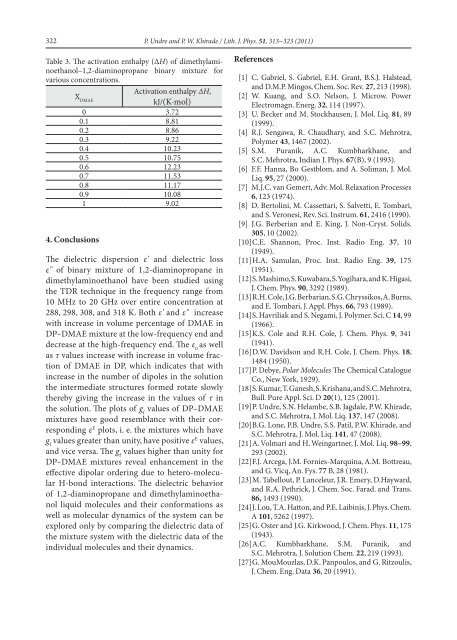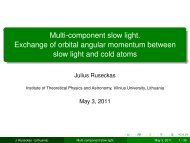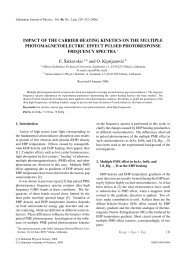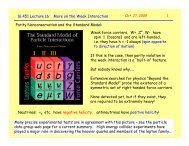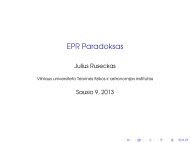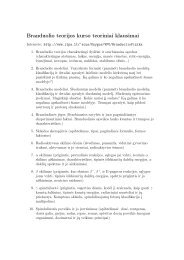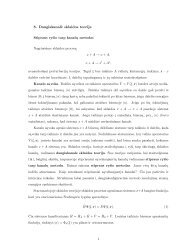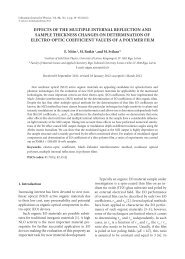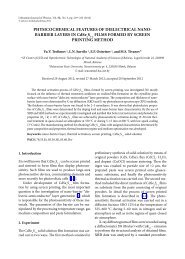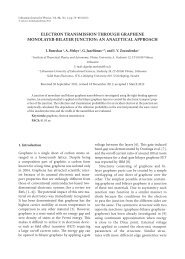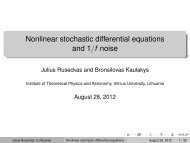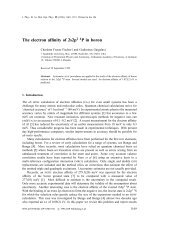DIELECTRIC DISPERSION IN 1,2-DIAMINOPROPANE ...
DIELECTRIC DISPERSION IN 1,2-DIAMINOPROPANE ...
DIELECTRIC DISPERSION IN 1,2-DIAMINOPROPANE ...
Create successful ePaper yourself
Turn your PDF publications into a flip-book with our unique Google optimized e-Paper software.
322<br />
P. Undre and P. W. Khirade / Lith. J. Phys. 51, 313–323 (2011)<br />
Table 3. The activation enthalpy (ΔH) of dimethylaminoethanol–1,2-diaminopropane<br />
binary mixture for<br />
various concentrations.<br />
X DMAE<br />
Activation enthalpy ΔH,<br />
kJ/(K.mol)<br />
0 3.72<br />
0.1 8.81<br />
0.2 8.86<br />
0.3 9.22<br />
0.4 10.23<br />
0.5 10.75<br />
0.6 12.23<br />
0.7 11.53<br />
0.8 11.17<br />
0.9 10.08<br />
1 9.02<br />
4. Conclusions<br />
The dielectric dispersion ε' and dielectric loss<br />
ε" of binary mixture of 1,2-diaminopropane in<br />
dimethylaminoethanol have been studied using<br />
the TDR technique in the frequency range from<br />
10 MHz to 20 GHz over entire concentration at<br />
288, 298, 308, and 318 K. Both ε' and ε" increase<br />
with increase in volume percentage of DMAE in<br />
DP–DMAE mixture at the low-frequency end and<br />
decrease at the high-frequency end. The ε 0<br />
as well<br />
as τ values increase with increase in volume fraction<br />
of DMAE in DP, which indicates that with<br />
increase in the number of dipoles in the solution<br />
the intermediate structures formed rotate slowly<br />
thereby giving the increase in the values of τ in<br />
the solution. The plots of g f<br />
values of DP–DMAE<br />
mixtures have good resemblance with their corresponding<br />
ε E plots, i. e. the mixtures which have<br />
g f<br />
values greater than unity, have positive ε E values,<br />
and vice versa. The g f<br />
values higher than unity for<br />
DP–DMAE mixtures reveal enhancement in the<br />
effective dipolar ordering due to hetero-molecular<br />
H-bond interactions. The dielectric behavior<br />
of 1,2-diaminopropane and dimethylaminoethanol<br />
liquid molecules and their conformations as<br />
well as molecular dynamics of the system can be<br />
explored only by comparing the dielectric data of<br />
the mixture system with the dielectric data of the<br />
individual molecules and their dynamics.<br />
References<br />
[1] C. Gabriel, S. Gabriel, E.H. Grant, B.S.J. Halstead,<br />
and D.M.P. Mingos, Chem. Soc. Rev. 27, 213 (1998).<br />
[2] W. Kuang, and S.O. Nelson, J. Microw. Power<br />
Electromagn. Energ. 32, 114 (1997).<br />
[3] U. Becker and M. Stockhausen, J. Mol. Liq. 81, 89<br />
(1999).<br />
[4] R.J. Sengawa, R. Chaudhary, and S.C. Mehrotra,<br />
Polymer 43, 1467 (2002).<br />
[5] S.M. Puranik, A.C. Kumbharkhane, and<br />
S.C. Mehrotra, Indian J. Phys. 67(B), 9 (1993).<br />
[6] F.F. Hanna, Bo Gestblom, and A. Soliman, J. Mol.<br />
Liq. 95, 27 (2000).<br />
[7] M.J.C. van Gemert, Adv. Mol. Relaxation Processes<br />
6, 123 (1974).<br />
[8] D. Bertolini, M. Cassettari, S. Salvetti, E. Tombari,<br />
and S. Veronesi, Rev. Sci. Instrum. 61, 2416 (1990).<br />
[9] J.G. Berberian and E. King, J. Non-Cryst. Solids.<br />
305, 10 (2002).<br />
[10] C.E. Shannon, Proc. Inst. Radio Eng. 37, 10<br />
(1949).<br />
[11] H.A. Samulan, Proc. Inst. Radio Eng. 39, 175<br />
(1951).<br />
[12] S. Mashimo, S. Kuwabara, S. Yogihara, and K. Higasi,<br />
J. Chem. Phys. 90, 3292 (1989).<br />
[13] R.H. Cole, J.G. Berbarian, S.G. Chryssikos, A. Burns,<br />
and E. Tombari, J. Appl. Phys. 66, 793 (1989).<br />
[14] S. Havriliak and S. Negami, J. Polymer. Sci. C 14, 99<br />
(1966).<br />
[15] K.S. Cole and R.H. Cole, J. Chem. Phys. 9, 341<br />
(1941).<br />
[16] D.W. Davidson and R.H. Cole, J. Chem. Phys. 18,<br />
1484 (1950).<br />
[17] P. Debye, Polar Molecules The Chemical Catalogue<br />
Co., New York, 1929).<br />
[18] S. Kumar, T. Ganesh, S. Krishana, and S.C. Mehrotra,<br />
Bull. Pure Appl. Sci. D 20(1), 125 (2001).<br />
[19] P. Undre, S.N. Helambe, S.B. Jagdale, P.W. Khirade,<br />
and S.C. Mehrotra, J. Mol. Liq. 137, 147 (2008).<br />
[20] B.G. Lone, P.B. Undre, S.S. Patil, P.W. Khirade, and<br />
S.C. Mehrotra, J. Mol. Liq. 141, 47 (2008).<br />
[21] A. Volmari and H. Weingartner, J. Mol. Liq. 98–99,<br />
293 (2002).<br />
[22] F.J. Arcega, J.M. Fornies-Marquina, A.M. Bottreau,<br />
and G. Vicq, An. Fys. 77 B, 28 (1981).<br />
[23] M. Tabellout, P. Lanceleur, J.R. Emery, D.Hayward,<br />
and R.A. Pethrick, J. Chem. Soc. Farad. and Trans.<br />
86, 1493 (1990).<br />
[24] J. Lou, T.A. Hatton, and P.E. Laibinis, J. Phys. Chem.<br />
A 101, 5262 (1997).<br />
[25] G. Oster and J.G. Kirkwood, J. Chem. Phys. 11, 175<br />
(1943).<br />
[26] A.C. Kumbharkhane, S.M. Puranik, and<br />
S.C. Mehrotra, J. Solution Chem. 22, 219 (1993).<br />
[27] G. MouMouzlas, D.K. Panpoulos, and G. Ritzoulis,<br />
J. Chem. Eng. Data 36, 20 (1991).


